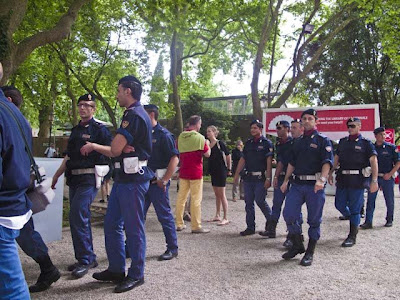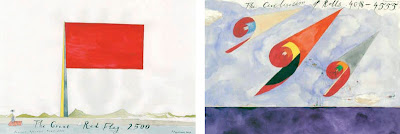 this image and the one below: Jef Geys, Quadra Medicinale, Belgium Pavilion
this image and the one below: Jef Geys, Quadra Medicinale, Belgium PavilionIt is well known that the ingestion of too much strong art can lead to incoherent babbling, convulsions and bleeding at the ears. There was no going back for us now though; we were going to risk exposure of the most dangerous kind. It was day three at the Venice Biennale and we were balanced on the edge of a fjord of artistic endeavor; greased and goggled we were ready to belly-flop gracelessly in.
The Belgium pavilion was close to the Illy stand so it received our attentions early on. Jef Geys was showing a collaborative, quasi-scientific work entitled Quadra Medicinale. De Geys engaged four acquaintances, each living in large cities, New York, Moscow, Brussels and Villeurbanne; he allotted them each a single square kilometer to search out twelve wild plants growing in the streets. The results of this research were catalogued, including any medicinal properties the plants had and then they were presented by means of framed dried samples alongside 'in situ' photographs, maps, analytical drawings and descriptive text.
Geys' deceptively simple undertaking operates on many levels. Visually the work is aesthetically arresting in the same way that a Durer anatomical drawing or the page from a da Vinci sketchbook is. The work also invites us to question what we value. Geys employs the word terroir to ground his creative intention; terroir is a term used in the wine trade and refers to inherent and unreproducible qualities in the wine born out of its origination in a specific geographical origin. He subtly re-appropriates this familiar idea and introduces it into the context of his project.
 In global historical terms the total separation of art and science, which of course we now take for granted, is a relatively recent phenomenon. People had once accepted that strict empiricism was dry and ultimately of limited practical use without the appropriate creative vision through which to interpret it. Science and Art were holistically and co-operativley engaged in the unravelling of the mysteries of our shared existence. Gey's undertaking goes a long way to re-establishing this vital connection.
In global historical terms the total separation of art and science, which of course we now take for granted, is a relatively recent phenomenon. People had once accepted that strict empiricism was dry and ultimately of limited practical use without the appropriate creative vision through which to interpret it. Science and Art were holistically and co-operativley engaged in the unravelling of the mysteries of our shared existence. Gey's undertaking goes a long way to re-establishing this vital connection.Belgium had a small press launch, in keeping with a country's size and stature. They were passing out freely flutes of dry sparkling wine outside the pavilion along with crusts of dry bread and small quantities of dry cheese. From the photograph below you can see that the yachting set are mixing freely, elbows sharpened, with two 'gentlemen of the road' (check the man in the cap) who had been waited in in the Giardini for almost two months for this very event.

The extraordinarily exciting prospect of receiving that mystical 'free lunch', however meager, was just too much for some and prompted much wailing, gnashing of teeth and flailing of limbs as they fought to secure their share. I approached the table from behind thus avoiding the stampede and secured an armful of stale bread amidst howls of protest from the trampled masses; I then fed it to the birds in the hopes of further provoking the situation.
I spoke to one of the 'gentlemen of the road' afterwards and he told me of a night shelter not five miles into the mainland where the bread isn't stale and you don't risk serious injury attaining it. I thanked him and told him I would bear it in mind for a future trip.

The next day we saw a heavy conflagration of suited and booted carabinieri fiddling nervously with their nightsticks; the official story ran that they were there because the king and queen of America were visiting for the award ceremony but the truth was Estonia were giving away out of date muffins at their press launch and they anticipated a riot. The crazy fools, will they never learn!


















